Method, apparatus and computer program product for high speed memory testing
a memory and high-speed technology, applied in the direction of resistance/reactance/impedence, testing circuits, instruments, etc., can solve the problems of synchronizing all the cards, limiting the patterns of alu, and not being able to generate patterns without substantial constraints
- Summary
- Abstract
- Description
- Claims
- Application Information
AI Technical Summary
Benefits of technology
Problems solved by technology
Method used
Image
Examples
Embodiment Construction
[0043]The claims at the end of this application set out novel features which applicants believe are characteristic of the invention. The invention, a preferred mode of use, further objectives and advantages, will best be understood by reference to the following detailed description of an illustrative embodiment read in conjunction with the accompanying drawings.
[0044]Referring now to FIG. 4A, test system 400A is illustrated in block diagram form, according to an embodiment of the present invention. For the illustrated embodiment of the present invention, test packets are produced in computer system 420 by software processes before testing begins. In other words, test packets are “preprocessed” by software block 402. More specifically, test program 404, which receives test specification 401 via programmer interface 403, is converted by a bit vector generator 405 (also referred to herein as a pin vector generator) that has specialized ALU software in a conventional computer system 420...
PUM
 Login to View More
Login to View More Abstract
Description
Claims
Application Information
 Login to View More
Login to View More - R&D
- Intellectual Property
- Life Sciences
- Materials
- Tech Scout
- Unparalleled Data Quality
- Higher Quality Content
- 60% Fewer Hallucinations
Browse by: Latest US Patents, China's latest patents, Technical Efficacy Thesaurus, Application Domain, Technology Topic, Popular Technical Reports.
© 2025 PatSnap. All rights reserved.Legal|Privacy policy|Modern Slavery Act Transparency Statement|Sitemap|About US| Contact US: help@patsnap.com



